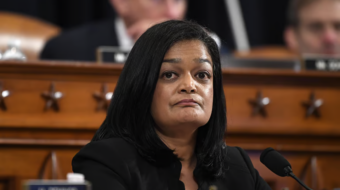
The new documentary Stars and Strife wants you to know that the world, and particularly the United States, is in trouble. It presents a compelling argument regarding the ills of society like poverty, racism, and political corruption. Where it falls short is in its presentation of a solution. Stars and Strife seemingly has good intentions for a better world, but its skewed take on capitalism may leave many viewers unconvinced.
Written and directed by financial adviser David Smick, Stars and Strife explores what it believes is an epidemic of hate that has left the U.S. vulnerable in the face of crisis. The crisis it is referring to is the current global pandemic that has already claimed the lives of over 200,000 Americans (roughly one-fifth of all worldwide COVID-19 deaths). Through news clippings and interviews with various professionals in government, economics, and activism, the film attempts to drive home the idea of unity. The filmmaker states that “our politics value opponents’ demise over dialogue—and our elected officials put party over country.” The idea of unity is a formidable one. Yet, exactly what kind of system is the film proposing for us to unify under?
At 97 minutes, the documentary does a good job of keeping the viewer’s attention. The interviews are vibrant and lively, while the news clippings and graphics do well to explain the ideas that Smick wants to get across. The strongest part of this film is the first half, mainly because it makes some valid points on what exactly is going wrong in the U.S. currently.
The film talks about the widening wealth gap between working-class people and the wealthy. It points out how greed and the favoring of corporate profits over human lives have created a tale of two cities in the United States. Stars and Strife takes aim at big corporations and what it calls corporate capitalism. It also appropriately brings up the insidious roles that banks have played in growing debt and inflation.
Another strong point in the documentary concerns political parties and voting. The film makes a point in saying that the current political system is designed to leave room only for a “duopoly” between Democrats and Republicans. It makes the assertion that because of this, these two parties get lobbied by powerful wealthy elites that get to have influence over policy and law. A case is made for opening up the political arena so that independent parties have more of a fighting chance on the electoral terrain. A way to do this, as one expert in the film noted, is through ranked voting.
Ranked voting allows voters to rank their choices, as opposed to picking only one candidate or the other. Through a series of eliminations in ranking, it would then leave one candidate who would in theory have the true majority. The film puts forth the idea that this would give us winning candidates more beholden to the people, who would have to put forth policies to truly win the public over.
The documentary falls short when it attempts to explain why things are the way they are, and how concrete change can occur. Stars and Strife expresses that the system we live under is a crumbling one, but instead of finding an alternative, it wants us to superglue the broken pieces back together again.
The film vilifies corporate capitalism and says that instead, we need to go back to “Main Street capitalism.” Through a series of graphics, Smick makes a case that under corporate capitalism only big corporations get richer while working people never have a chance for upward mobility. Smick asserts that this is not the case under Main Street capitalism, where the American dream can still be realized and success is possible for everyone. Smick himself says he thinks every person from birth should be made a capitalist and given a loan to start their own business.
There are, of course, problems with this assessment.
Capitalism, in any form, puts profit at the center of its functioning, and thus it can be argued that any form of capitalism will be and has been exploitative. The idea under capitalism is that for someone to make a lot of money someone else has to make less. The film tries to put forth that anyone can be a boss. This just isn’t true under capitalism because bosses need workers in order to make a profit. In fact, the boss’s extreme profit hinges on paying the workers less. The better question should be why anyone needs to make more money than anyone else in order for society to flourish.
Smick seems to rely on the often used argument that capitalism, as opposed to socialism and communism, inspires innovation because people have the incentive of money and riches. Smick believes that the only reason why innovation is down under capitalism is because corporations have gobbled up all the profit, thus making potential entrepreneurs less willing to take a risk and start a new business. It may be true that corporations dominate the market, but capitalism has always treated workers poorly. The gains made for workers—the 8-hour workday, higher wages, safer conditions on the job—have all been made not by benevolent “Main Street” capitalists, but through workers themselves organizing, striking, and demanding them.
This reviewer would argue that the road forward isn’t going back under a (reformed) system that is already known to cause damage and class division. A better solution would be looking into other systems that can encourage solidarity and humanitarianism. This of course is a no-go in Stars and Strife because early on Smick makes a point to dismiss socialism and communism. Many of the people interviewed in the film are from previous White House administrations that also see no benefit in truly changing the way things are done. The main sentiment is that people just need to be nicer to each other, and not condemn the other side constantly.
One could argue that these drawbacks I mention are steeped in my own political bias. I would counter that had the film has actually taken on other viewpoints instead of outright dismissal, while bringing in other professionals who didn’t already agree with the filmmaker, it would have made for a stronger movie. It would have made it so that even if a viewer didn’t agree with the conclusion, they could at least admit that an attempt at a robust discussion on the topic had been made. That’s not what happens in Stars and Strife.
Instead, it gives us the doom and gloom caused by a capitalist society and then tells us we just need a nicer form of capitalism to fix it. The good intentions to fix the system are there in the film. Yet, as the saying goes, the road to hell is paved with good intentions. Stars and Strife is an easy watch, but if you’re looking for a concrete road forward you won’t find it here.
Stars and Strife can currently be seen on STARZ. The trailer can be viewed here.










